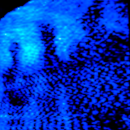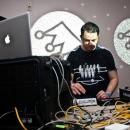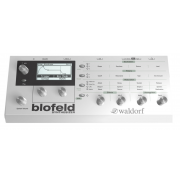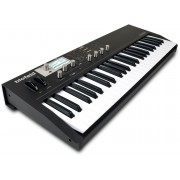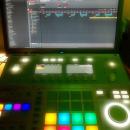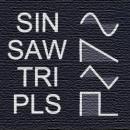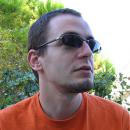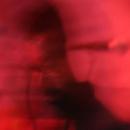#4032
Blofeld
Main
• Unbeatable price tag
• sturdy Metal Enclosure
• 7 endless stainless steel Dials
• Graphic Display 128 x 64 pixels, b/w, white background LED
• more than 1000 Sounds
• 3 Oscillators per voice
• Frequency Modulation between the Oscillators
• All Q Oscillator Models
• All Microwave II/XT/XTk Wavetables
• 2 independent Multi Mode Filters per voice
• Filter FM
• 2 Drive stages per voice with selectable Drive Curves
• 3 fast LFOs per voice
• 4 fast Envelopes per voice
• powerful Arpeggiator
• freely programmable Arpeggiator Pattern with up to 16 Steps per Sound
• up to 25 Voices
• 16 part multi timbral
• more than 1000 Sounds
• sturdy Metal Enclosure
• 7 endless stainless steel Dials
• 5 Buttons
• Graphic Display 128 x 64 pixels, b/w, white background LED
• MIDI LED
• Volume Control
• Power Switch
• Stereo Output
• Headphone Output
• MIDI In
• USB Connector for MIDI In / Out
- uses standard USB MIDI Driver provided by host computer OS
- Windows ME minimum, Windows XP or newer recommended
- Mac OS X 10.2 minimum, Mac OS X 10.3 or newer recommended
• External Power Supply
Parts
• powerful Arpeggiator
- Hold and One Shot modes
- syncable to MIDI Clock
- Direction Up, Down, Alternate
- Range up to 10 Octaves
- various methods to modify Note Sort Order
• freely programmable Arpeggiator Pattern with up to 16 Steps per Sound.
programmable per Step:
- Accent
- Timing
- Length
- Glide on/off
- Pause
- Chord
- Previous note
- Random not from Note List
- first and/or last note from Note List
• 1 Effect slot per part
• 1 Effect slot globally for all parts
Effect types:
- Chorus
- Flanger
- Phaser
- Overdrive
- Triple FX (S&H, Ring Modulation, Chorus)
- Delay (only available on global Effect slot)
- Clocked Delay (only available on global Effect slot)
- Reverb (only available on global Effect slot)
Voices
3 Oscillators Virtual Analog Models:
Pulse with Pulse Width Modulation and adjustable Brilliance
Sawtooth with adjustable Brilliance
Triangle
Sine
Wavetables:
Q Alt 1 and Alt 2 Wavetable with adjustable Brilliance
All Wavetables from Microwave II/XT/XTk Series with adjustable Brilliance
Separate Wavetable selectable for Oscillator 1 and 2
Frequency Modulation between the Oscillators
Oscillator Synchronization
Ring Modulator for Osc 1 / 2
Noise Generator with Noise Colour
2 independent Multi Mode Filters
Filter FM
Resonance up to Self-Oscillation
Low Pass 24 dB / 12 dB
Band Pass 24 dB / 12 dB
High Pass 24 dB / 12 dB
Notch 24 dB / 12 dB
Comb Filter with positive / negative Feedback- PPG Low Pass Filter
2 Drive stages per voice with adjustable Drive Gain and selectable Curves
Clip
Hard
Medium
Soft
Sine Shaper
etc.
Modulation Matrix with 16 Slots, freely programmable
Modulation Speed far into Audio Range
Modulation Sources include all internal Modulation Sources plus various MIDI messages
Modulation Destinations for almost all continuous sound parameters
various pre-routed Modulation Destinations with selectable Sources
Pitch Modulation
Oscillator 1 / 2 / 3 Frequency Modulation
Oscillator 1 / 2 / 3 Pulse Width Modulation
Filter 1 / 2 Cutoff Modulation
Filter 1 / 2 Frequency Modulation
Pan 1 / 2 Modulation
Amp Modulation
4 Modifiers for transforming Modulation Sources with various Algorithms
3 fast LFOs
syncable to MIDI Clock
Note Retrigger with adjustable Start Phase
monophonic LFO
Keytrack
4 fast Envelopes with selectable types
Single Trigger / Retrigger per Envelope
ADSR
ADS1DS2R (2 Decay/Sustain stages plus adjustable Attack Level)
One Shot
Loop S1S2 (Loop between Sustain 1 and 2)
Loop All (Loop over all stages)
Poly, Mono, Dual or Unisono Mode with selectable Voice Count
Oscillators
Each of the three oscillators offers authentic circuit-models of analog waveforms: Pulse with variable pulse-width, sawtooth, triangle and, as found in relatively few analog synthesizers these days, sine wave.Furthermore, oscillators 1 and 2 feature the two wavetables that were introduced by the Waldorf Q and appeared shortly thereafter in the Micro Q series.
Not only that, the Blofeld includes all ROM Wavetables from the mighty flagship Waldorf Wave as well as Microwave II/XT. Plus, lo and behold, the desperately requested "Upper Wavetable" from the good old PPG Wave! But, for the first time in the history of Waldorf and PPG, each of these two oscillators can have its own wavetable.
What's more, you have control over the brilliance of these wavetables, which is especially important for waves with lots of harmonics in the bass end. You decide if you prefer pure and perfect harmonics or the same edgy timbre you know and love from the earlier Waldorf and PPG synthesizers.
Brilliance also affects the sawtooth and pulse oscillator models. From warm and soft (for those typical L.A. string pads) to the hard shapes you need for punchy and biting bass sounds. But note, Brilliance is not a simple filter applied after the oscillators, the model itself is modified.
Each of the three oscillators can be frequency-modulated by any of the other oscillators, the noise generator or one of the LFOs. With low FM amounts, you can add a little dirt to the oscillator sound, with higher amounts you get typical FM effects.
On top of all that, oscillator 2 can be hard-synced to oscillator 3.
Selecting one of the oscillators brings up one of the oscillator pages. Each oscillator, the ring modulator and the noise generator can be mixed freely into the two separate multimode filters.
A special overview page displays this routing as well as the levels and shapes of the tone generators.
Ring Modulation
Oscillators 1 and 2 can be ring-modulated to create bell-like or metallic sounds, eerie sound effects as well as pumping basses and leads.
The noise generator delivers white noise that can be filtered low or high pass, depending on the Noise Colour setting.
The three oscillators, the ring modulator and the noise generator can be freely mixed into filter 1 and filter 2. This allows fine control over the harmonic content of each of the tone generators.
Filters
The Blofeld has two multimode filters per voice that can be routed in series or in parallel. Each Filter has its own Pan parameter for easy creation of stereo sounds.
The selection of filter types includes low pass, band pass, high pass and notch (band reject), each with 12dB/oct or 24dB/oct slope. The filter models are based on several famous Waldorf filter algorithms found in all our products. They offer resonance up to self-oscillation as well as frequency modulation (filter FM).
Furthermore, the Blofeld features the same comb filter types (with positive and negative feedback) that we first introduced in the Waldorf Q. These can be used to thicken bass and pad sounds or to create percussive, string or flute sounds reminiscent of physical modelling.
Of course the two filters have dedicated pages showing filter response curves. Here is an example of the response of the 24dB low pass type.
Even the comb filter types are displayed graphically.
Filter Routing
Waldorf Blofeld FilterThe two filters can be routed in series or parallel, the latter allowing you to pan both filters individually.
Overdrive, Saturation, Distortion, Shaping
You name it. The Blofeld offers a freely controllable "Drive" behind each filter with more than a dozen curves. These include such standards as the drive from the Q and Micro Q, low/medium/hard saturation, tube saturation, two types of electric pickups, a rectifier, digital overflow as well as esoteric stuff such as "binary distortion", a sinusoidal waveshaper and even a distortion controlled by oscillator 1. And because the Blofeld has two filters that can be routed in series, you can control the timbre of the drive output of Filter 1 by dampening or emphasizing certain frequencies with filter 2.
Effects
The Blofeld has two effect slots with various types. In Multimode, the first effect slot is available per Part, while the second one is used for all 16 Parts (i.e. global) with controllable mix levels. Part 1 determines the settings of the second effect.
The first effect slot offers such modulation effects as chorus, flanger as well as a combined type called "Triple FX". The latter gives you several effects at once, but with a reduced parameter set.
The second effect slot offers all the same types as the first, but with the addition of delay, clocked delay and reverb.
Envelopes
Waldorf Blofeld EnvelopeFour envelopes with different types and trigger modes affect any sound parameters you choose.
Each envelope can be either polyphonic or single trigger. This is especially interesting with the monophonic voice allocation, as the filter envelope can be set to be triggered only by the first note(s) while the Amp Envelope is triggered anew (i.e. on each note). Think "organ percussion register", for instance.
The Envelope types include the standard ADSR as well as an enhanced ADSR-variant (with controllable attack level and two decay and sustain stages), two different loop envelopes and a "one shot" Envelope.
The Loop types can be used to act as additional LFOs, while the One Shot is perfectly suited for percussion sounds (which typically ignore the note release).
Next, there are the Envelopes, which can be the classic ADSR type, looped or without hold and release stages (one shot). All in all, there are five different types.
LFOs
Waldorf Blofeld LFO
Each of the three LFOs offers sine, triangle, square and sawtooth waveforms, plus sample & hold and random.
LFOs can be synchronized to MIDI clock, they can be polyphonic or monophonic, reset on key trigger to a freely definable phase, and the speed can be scaled by MIDI note (key follow). There are separate delay and fade in/out parameters for e.g. delayed vibrato (positive Fade values) or a burst of vibrato at the start of each note (negative Fade values).
One important feature of the Blofeld LFOs is that higher rates reach well into the audio frequency range, thus making them useful extra FM sources. There are two basic modes: either linear FM as seen in classic digital synths, or logarithmic FM, which is primarily the domain of analog modular systems.
The three LFOs offer separate parameters for delay and fade in/out.
Modulations
Here's where the real Waldorf power lies. Each and every instrument designed and built by Waldorf lets you connect dozens of modulation sources to all the important sound generation parameters.
Individual or multiple oscillator pitches, their pulsewidths and waveforms, their levels and filter-balances, FM modulation amounts, individual filter cutoff and resonance, filter FM amounts and stereo panning, or just the good old sound output level – everything can be controlled from internal modulation sources or from a variety of MIDI messages such as velocity, keytrack, continuous controllers (including wheels, breath and foot controllers) etc.
You can of course "modulate the modulators" i.e. control LFO speeds and individual envelope rates and levels. But in Blofeld you can even specify that these sources modulate themselves – recursive modulation! For instance, modulating an envelope rate by the same envelope (or another one) can alter the shape of the slope dramatically from the standard exponential curve to linear to inverse exponential.
Modifiers
And how many slots do you get in the mod matrix? Two? Three? Four? No, we're talking big here. You get 16 freely definable slots plus all the pre-routed modulation destinations such as pitch, Osc 1, 2 and 3 frequency and PWM (pulse width modulation), filter 1 and 2 cutoff, panorama and amp level modulation. And let's not forget that the filter envelope is already routed to filter 1 and 2 cutoff, and the amp envelope is routed to the amp level. Makes a total of 33 simultaneous connections if we counted correctly.
What if you want something really really crazy, like controlling a pitch vibrato done by LFO 3 with the modulation wheel. Although there are a few such composite modulation sources such as "LFO1*MW" (LFO 1 controlled by Modulation Wheel) and "LFO2*Press" (LFO 2 controlled by monophonic Aftertouch), there's nobody doing the "LFO3*MW" thing for you.
But, don't worry, that's where the Modifiers come into play. In seconds you can set up a new modifier, with the two sources set to LFO 3 and modulation wheel, and the "operation" set to "*" (multiply). You can use such custom-made modulation sources in any of the modulation slots described above.
Okay, maybe you are more the regular musician who simply wants to perform a binary OR between two modulation sources? Okay, go for it! This operation is just one of several at your service.
So what can you do with all these envelopes, LFOs and the other control sources? Apart from serving as direct modulation sources, you can easily connect them to other modulation destinations in the modulation matrix.
And if that's not enough, you can even create new modulation sources by modifying an existing one with algorithmic operations. Sounds too complicated? Maybe. But it is great fun even if you don't know what you are doing!
Waldorf Blofeld ModifierBy the way, the Modifier in the picture creates a "steppy" modulation based on the original continuous waveform of LFO 1, whatever that LFO waveform might be.
Arpeggiator
Waldorf Blofeld ArpeggiatorOkay, Blofeld's arpeggiator could very well become the biggest chapter of this page but let's try to keep it short...
It features variable clock divisions from 1/64 triplets to more than 1000 bars, with variable swing/shuffle, a range of up to 10 octaves. Up, down and alternate figures, selectable play order from low to high note, low to high velocity, as played or reversed, variable note length, different velocity modes. And Hold or One-Shot, if you like.
But more importantly, it has the most powerful Pattern Editor we have ever seen.
You can set each Step to either play the note it would do so anyway, to pause, to play the previous note again, play the first or the last note, play those together, play a chord consisting of all held notes or a randomly selected note.
Then you can adjust the Accent of each step (including silence), activate or deactivate Glide for each step, set the timing to play a step ahead or behind its nominal time, and finely adjust the note length between short staccato and full legato.
No wonder this arpeggiator had great reviews when it first appeared in the Waldorf Q. It will take you straight to arpeggiator-heaven, as has already happened to thousands of Waldorf customers. Dig it!
Last but not least, the Blofeld has a freely programmable arpeggiator that displays the pattern you have created.
Sound
Waldorf Blofeld Sound
Now, how does all that sound? You probably know that Waldorf synthesizers are well loved for their sound character, and the Blofeld is certainly no exception. But who are we to tell you? Better listen to the Waldorf Blofeld demos, visit your dealer or just believe us: it sounds great. Now go and get one!
The Blofeld has a gorgeous user interface with a huge graphic display giving you precise visual feedback. Seven endless rotaries plus a volume knob all made of steel invite you to explore the depth and power of Blofeld.
Selecting sounds is a breeze. If you just want to browse through the available sounds, use the dial above the Play button. If you want to jump to a different soundbank, use the left dial under the display. Selecting a category with the right dial (under the display) causes Blofeld to show only sounds belonging to that particular category.
Editing
Quick
Editing sounds to suit your needs is just as easy. The most frequently used parameters are laid out on the front panel. Just select the appropriate row with the four buttons to the left of the parameter matrix and turn the knobs.
This parameter matrix allows instant control over oscillator waveforms, semitone offset, detuning and levels – filter cutoff, resonance, type and envelope amount – envelope rates and levels (two of the four envelopes), LFO speed and shape (two of the three LFOs) – the modulation matrix, the effect mix – arpeggiator mode and clock.
Deep
As soon as you press one of the buttons of the parameter matrix, the display switches to the most appropriate page for that parameter set.
Sledge2
Introduction
Studiologic is proud to introduce a new 2.0 version of its renowned Sledge synthesizer, with new features and sound innovations that will set this instrument above any competitor, thanks to new mix of pure synthesis and sound sampling.
In addition to the incredible sound engine and the user’s friendly vintage control panel, the new features further expand the instrument’s power and versatility; Studiologic and Waldorf Labs (working as a team) have made Sledge 2.0 more flexible as a pure synthesizer, adding the ability to play in Dual Mode two programs at the same time, load Samples and mix post processing Effects in a never ending sound creation.
Sledge 2.0 Key features
NewFeaturesAuto Dual mode: Sledge 2.0 can now play two sounds at the same time, in Split or Layer mode; the feature is controlled by a new page of the Global function and allows to simply keep one note (for Split) or more notes (for Layer) and then select a new sound, that will be added to the previous sound; as any other sound, also Dual Sound combinations can be permanently stored in any of the 1.000 available presets;
Sample Player
Sound samples and new waves can be loaded in the internal 60 megabyte of Flash memory, played by OSC 1 and modifiable by all parameters of the control panel, adding other oscillators, setting filters, envelopes and effects. This feature can constantly expands the instrument’s sounds and create a totally new combination of synthesis and sampling.
Pitch & Hold
A new Global page allows to enable the Pitch and the Hold separately for the Lower and Upper sounds in Dual Mode, allowing to use the Pitch bend on the Upper sound (i.e. for solo parts) and the Hold pedal to control only the Lower (to keep playing a Drums groove or as a Damper for a Piano sound) and vice versa, or to enable Pitch Bend and Hold on both Upper and Lower sounds;
Reverb+Delay
A new function allows to mix both effects; the Reverb keeps the setting previously selected, while the real time controls (time and level) allows to set the parameters of Delay also when mixed.
Enhanced Polyphony
The total maximum number or notes that can be played at the same time have been expanded to 24, allowing to get a better real time control over the new sound possibilities obtainable from synthesis and sampling together.
Sledge Spectre
Samples can be edited (keyboard range, tuning and other parameters) and transmitted to Sledge 2.0 by the USB port, with this easy sample editor that allows to first load and play the samples on your Computer and then download them into the instrument’s memory.
Keyboard 61 keys + Aftertouch
35 Pots - 3 “chicken head” rotary switches (7 positions) - 1 rotary encoder + push function
2 x 16 digits backlit LCD
High Quality Pitch and Mod Wheels
Up to 999 programmable Sounds
Fast and efficient sound selection via numeric keypad
MODULATION
2 fast LFOs per voice with adjustable Speed and Depth
1 extra modulation routing for Mod Wheel, with adjustable Speed and Depth
- LFO Shape: Sawtooth, Rectangular, Triangle, Sine, Sample & Hold, Ramp
- Destination: Osc 1, Osc2, Ocs3, PWM / Wave / FM, Volume, Filter Cutoff
SOUND GENERATION
24 Voices polyphony - Monophonic mode with single or multiple trigger
3 Oscillators per voice OSC1/OSC2/OSC3
- Range from 64' to 1' with Semitone ant Detune controls
- Shapes: Sawtooth, Square, Triangle, Sine, Pulse (with Pulse Width Modulation)
- OSC 1 with 66 Original PPG Wavetables + Sample Player (60MB internal memory)
FM - Frequency Modulation of Sine and Triangle - Oscillator Hard sync (OSC 2 to OSC 3)
Noise Generator - White and Pink noise
Mixer with Volume and On/Off switch for each Oscillator and Noise
AUTO DUAL MODE
Split or Layer mode – prog. split point for each Program
FILTER & AMPLIFIER
1 Multi Mode Filter per voice - 24 / 12dB - Lowpass - Highpass - Bandpass
- Resonance up to Self-Oscillation and beyond - Adjustable Key track and Drive
2 fast Envelopes per voice (Filter-Amplifier) with Amount and Velocity control (Filter+Ampli)
ARPEGGIATOR
Powerful Arpeggiator - Latch mode - syncable to MIDI Clock
- Direction Up, Down, Alternate - Range up to 10 Octaves
EFFECTS
2 simultaneous Effects
- Effect 1: Chorus / Phaser / Flanger
- Effect 2: Reverb / Delay / Reverb+Delay
CONTROLS & CONNECTIONS
Master Volume Control
Power Switch
Stereo line output
Headphone output
Expression pedal input
MIDI IN / OUT
USB connector for MIDI IN/ OUT, Firmware Update, Samples Loading (with Spectre)
- uses standard USB MIDI driver provided by host computer OS
- Windows ME minimum, Windows XP or newer recommended
- Mac OS X 10.2 minimum, Mac OS X 10.3 or newer recommended
Built in power supply
SIZE/WEIGHT
97 cm x 40,5 cm x 11 cm
38,19" x 15,94" x 4,33"
8,3 Kg | 18,3 lbs
ADDITIONAL PACKAGE CONTENT
Power Cord
CD Manual
MicroWave1(Rev.A or Main Green)
Specifications
Polyphony - 8 voices, 8-part multitimbral
Oscillators - 64 ROM wavetables and waveform samples
VCF - Analog Curtis CEM3389 24 dB/oct lowpass filter
VCA - 4 envelopes
Effects - None
Vocoder - Speech Synthesizer
Arpeg/Seq - None
Keyboard - None
Memory - 64 internal, 64 external card
Control - MIDI
Date Produced - 1989
Type: Synth/ module/
Synthesis Type: Digital Analog 64 Wavetables in ROM, each with 64 Waveforms ( in V2.0 )12 User Programmable Wavetables with 64 User Programmable Analog 24dB Low Pass Filters with Resonance up to self oscillation and overdrivable inputwavetable synthesis (with nice filters)
Polyphony:
Max: 8
Typical in use: 8
Multi-timbral (number of parts): 8
Oscillators per Voice :
Min : 1
Max : 2+ noise
Controllers :
Keyboard :
Number of Keys :
Can send on simultaneous MIDI channels
Responds to :
Sounds can be split by :
Memory :
Patches : 64 internal 64 on card
Performances : 64 internal 64 on card
Inputs and Outputs :
Number of Audio Outs (excluding Phones) : 1 stereo + 4 mono
Number of Audio Ins : up to 4 with modification
Number of MIDI Outs (excluding Thru) : 1
Number of MIDI Ins : 1
Upgrade Options : You should be able to download new wavetables via SysEx or cards
Comments about the sounds :
This baby is a specialist on strange syntesizer-sounds. It's an modern PPG-lookalike!
http://www.polynominal.com/site/studio/gear/synth/waldorf_microwave/microwave.html

